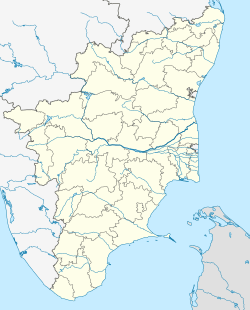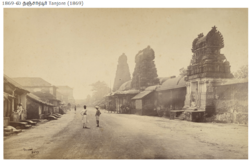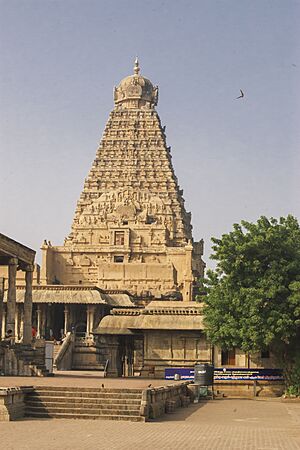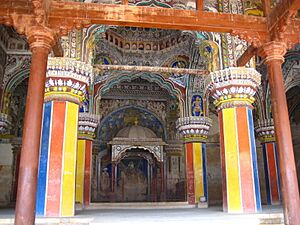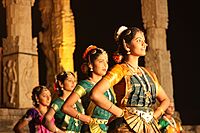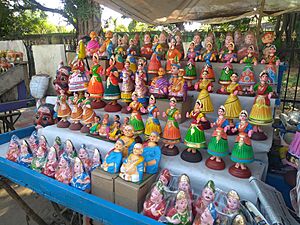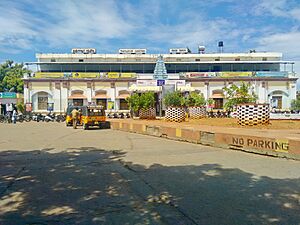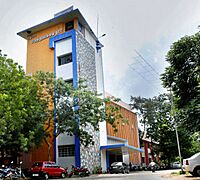Thanjavur facts for kids
Quick facts for kids
Thanjavur
(Tanjore)
|
|
|---|---|
|
City
|
|
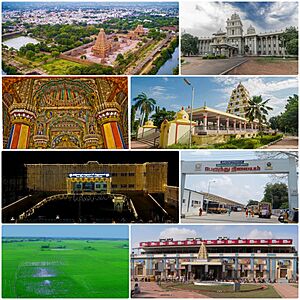 |
|
| Country | |
| State | |
| District | Thanjavur |
| Region | Cauvery Delta |
| Founded by | Raja Raja Chola - I |
| Government | |
| • Type | City Municipal Corporation |
| • Body | Thanjavur Municipal Corporation |
| Area | |
| • Total | 36.31 km2 (14.02 sq mi) |
| Elevation
52
|
77 m (253 ft) |
| Population
(2011)
|
|
| • Total | 222,943 |
| • Rank | 11th in Tamil Nadu |
| • Density | 6,140.0/km2 (15,902.5/sq mi) |
| Demonym(s) | Thanjavurkaaran |
| Languages | |
| • Official | Tamil |
| Time zone | UTC+5:30 (IST) |
| PIN |
613 0XX
|
| Telephone code | 04362 |
| Vehicle registration | TN-49 |
| Website | thanjavurcorporation.org |
Thanjavur (Tamil: [t̪aɲdʑaːʋuːɾ]), also known as Thanjai, was once called Tanjore. It is a city in the Indian state of Tamil Nadu. Thanjavur is the 11th largest city in Tamil Nadu. It is a very important place for South Indian religion, art, and architecture.
Many of the Great Living Chola Temples are found near Thanjavur. These temples are so special that they are UNESCO World Heritage Monuments. The most famous one is the Brihadeeswara Temple. Emperor Rajaraja I of the Chola dynasty built this temple right in the city center. It has one of India's largest bull statues, called Nandi, carved from a single granite rock.
Thanjavur is also famous for Tanjore painting. This is a special painting style unique to the area. The city is the main office for the Thanjavur District. It's a key farming area in the Kaveri Delta and is known as the Rice bowl of Tamil Nadu. A municipal corporation manages Thanjavur. It covers an area of 36.31 km2 (14.02 sq mi) and had about 222,943 people living there in 2011. Roads are the main way to travel, but the city also has train connections. The closest airport is Tiruchirapalli International Airport, about 59.6 km (37.0 mi) away. The nearest seaport is Karaikal, which is 94 km (58 mi) from Thanjavur.
The city first became important when the Cholas ruled. It was their capital city. After the Cholas, different groups ruled Thanjavur. These included the Mutharaiyar dynasty, the Pandyas, the Vijayanagar Empire, the Madurai Nayaks, the Thanjavur Nayaks, the Thanjavur Marathas, and the British Empire. India became independent in 1947, and Thanjavur has been part of independent India since then.
Contents
- What Does the Name Thanjavur Mean?
- A Look at Thanjavur's Past
- Thanjavur's Location and Weather
- Exploring Thanjavur: Culture and Fun
- Thanjavur's Economy: How People Make a Living
- People and Languages in Thanjavur
- Getting Around Thanjavur
- Learning and Education in Thanjavur
- City Services in Thanjavur
- Nearby Villages
- See also
What Does the Name Thanjavur Mean?
The city's name might come from "thanjam puguntha oor" (Tamil: தஞ்சம் புகுந்த ஊர்). This means "the town where refugees entered." It suggests the city has a history of welcoming new people.
Another local story says the name "Thanjavur" comes from "Tanjan." Tanjan was a demon who was defeated here. In Hindu mythology, Tanjan asked for a beautiful city to be built where he was defeated. The Hindu god Neelamegha Perumal, a form of Vishnu, defeated the demon in what is now Thanjavur.
Some also think the name "Thanjavur" comes from a Mutharayar king named "Thananjay" or "Dhananjaya." Adding "Oor" (meaning town) to Thananjay gives Thanjavur.
A Look at Thanjavur's Past
There are no old records from the Sangam period (around 3rd century BCE to 4th century CE) that mention Thanjavur. However, some experts believe the city existed back then. A place called Kovilvenni, about 15 miles (24 km) east of the city, was where the Battle of Venni happened. In this battle, the Chola king Karikala fought against the Cheras and Pandyas.
The Cholas became powerful again around 850 CE. This was thanks to the Medieval Chola king Vijayalaya (841–878 CE). Vijayalaya took Thanjavur from the Mutharayar king Elango Mutharayar. He built a temple for the goddess Nisumbhasudani. His son Aditya I (871–901) made sure the Cholas kept control of the city.
Thanjavur slowly became the most important city in the Chola Empire. It was their capital until Gangaikonda Cholapuram became the new capital around 1025. In the early 11th century, the Chola king Raja Raja Chola I (985–1014) built the famous Brihadeeswarar Temple in Thanjavur. This temple is seen as one of the best examples of Tamil architecture.
In the 13th century, the Chola Empire started to weaken. The Pandyas from the south attacked and took Thanjavur twice. The Chola king Rajaraja Chola III (1216–56) even had to leave. He got help from the Hoysala king Vira Narasimha II (1220–35) to get Thanjavur back.
Eventually, the Pandya king Maravarman Kulasekara Pandyan I (1268–1308) took over Thanjavur in 1279. The Chola kings then had to accept the Pandyas as their rulers. The Pandyas ruled Thanjavur until 1311. Then, the forces of Malik Kafur (1296–1306) attacked their kingdom. Later, the Delhi Sultanate took control.
From the 1350s, the Vijayanagar Empire slowly took over the region. Sevappa Nayak (1532–80) became an independent ruler in 1532. He started the Thanjavur Nayak kingdom. The Nayak rulers were known for supporting literature and arts. Their rule ended in 1673 when the Madurai Nayak king Chokkanatha Nayak (1662–82) captured Thanjavur.
In 1674, Ekoji I (1675–84) conquered Thanjavur. He was a Maratha leader and half-brother of Shivaji. Ekoji started the Thanjavur Maratha kingdom, which ruled until 1855. The Maratha rulers supported Carnatic music. In 1787, Amar Singh took the throne from the young Raja Serfoji II (1787–93). But Serfoji II got his throne back in 1799 with help from the British. He gave the British control of the kingdom's administration.
The British took over the kingdom completely in 1855. This happened because Shivaji II (1832–55), the last Maratha ruler, died without a male heir. The British called the city Tanjore. In 1871, Thanjavur was the third-largest city in the Madras Presidency. After India became independent in 1947, Thanjavur remained an important district center.
Thanjavur's Location and Weather
Thanjavur is located at 10°48′N 79°09′E / 10.8°N 79.15°E. Rivers like the Grand Anaicut canal (Pudhaaru), Vadavaaru, and Vennaaru flow through the city. Thanjavur is in the Cauvery delta. It is about 340 km (210 mi) southwest of Chennai and 56 km (35 mi) east of Tiruchirappalli.
Most of Thanjavur city and its nearby areas are in the "New Delta." This was a dry area that got water for farming in the early 19th century. The city is 59 m (194 ft) above sea level. The total area of the city is 36.33 km2 (14.03 sq mi).
| Climate data for Thanjavur (1981–1999, extremes 1975–1999) | |||||||||||||
|---|---|---|---|---|---|---|---|---|---|---|---|---|---|
| Month | Jan | Feb | Mar | Apr | May | Jun | Jul | Aug | Sep | Oct | Nov | Dec | Year |
| Record high °C (°F) | 34.2 (93.6) |
38.5 (101.3) |
41.4 (106.5) |
43.0 (109.4) |
43.4 (110.1) |
43.0 (109.4) |
41.6 (106.9) |
41.2 (106.2) |
40.2 (104.4) |
40.5 (104.9) |
35.6 (96.1) |
36.0 (96.8) |
43.4 (110.1) |
| Mean daily maximum °C (°F) | 30.8 (87.4) |
33.3 (91.9) |
36.0 (96.8) |
38.1 (100.6) |
39.1 (102.4) |
37.7 (99.9) |
37.0 (98.6) |
36.5 (97.7) |
35.2 (95.4) |
33.4 (92.1) |
30.7 (87.3) |
29.6 (85.3) |
34.8 (94.6) |
| Mean daily minimum °C (°F) | 20.6 (69.1) |
21.5 (70.7) |
23.6 (74.5) |
26.3 (79.3) |
27.2 (81.0) |
26.8 (80.2) |
26.2 (79.2) |
25.7 (78.3) |
24.9 (76.8) |
24.4 (75.9) |
22.8 (73.0) |
21.4 (70.5) |
24.3 (75.7) |
| Record low °C (°F) | 17.1 (62.8) |
16.6 (61.9) |
18.4 (65.1) |
20.5 (68.9) |
21.0 (69.8) |
22.5 (72.5) |
21.5 (70.7) |
21.6 (70.9) |
21.0 (69.8) |
21.0 (69.8) |
19.0 (66.2) |
17.0 (62.6) |
16.6 (61.9) |
| Average rainfall mm (inches) | 25.7 (1.01) |
15.1 (0.59) |
14.9 (0.59) |
21.0 (0.83) |
36.1 (1.42) |
44.2 (1.74) |
62.9 (2.48) |
127.3 (5.01) |
144.9 (5.70) |
170.3 (6.70) |
180.6 (7.11) |
157.4 (6.20) |
1,000.5 (39.39) |
| Average rainy days | 1.7 | 0.8 | 0.8 | 1.2 | 2.3 | 2.8 | 3.5 | 6.0 | 6.7 | 8.1 | 8.0 | 6.6 | 48.4 |
| Average relative humidity (%) (at 17:30 IST) | 63 | 53 | 49 | 52 | 51 | 50 | 49 | 52 | 61 | 68 | 75 | 74 | 58 |
| Source 1: India Meteorological Department | |||||||||||||
| Source 2: CRIDA | |||||||||||||
The weather in Thanjavur is nice from November to February. Days are warm, and nights are cool. Summer starts in March, with the hottest temperatures in May and June. Average temperatures range from 81 °F (27 °C) in January to 97 °F (36 °C) in May and June.
There isn't much rain in summer. The first monsoon, the South-west monsoon, starts in June and lasts until September. The Northeast monsoon begins in October and continues until January. The North-East monsoon brings a lot of rain, which is good for the region. The average rainfall is 37 inches (940 mm). Most of this rain comes from the North-East monsoon.
Exploring Thanjavur: Culture and Fun
Thanjavur is a popular place for pilgrims and tourists in Tamil Nadu. The South Zone Culture Centre in Thanjavur helps protect and promote India's cultural heritage. In 2009, over 2 million Indian and 81,000 foreign tourists visited Thanjavur.
The most visited place is the Brihadeeswarar Temple. Historian Percy Brown called its building a "landmark" in South Indian architecture. King Raja Raja Chola I (985–1014) built this temple in the 11th century. It is dedicated to the Hindu god Shiva. The temple walls have old paintings from the Chola and Nayak periods. In 1987, UNESCO named it a UNESCO World Heritage Site.
The Thanjavur Maratha palace was where the Bhonsle family lived. They ruled Thanjavur from 1674 to 1855. The Nayak rulers first built it. After they fell, it became the home of the Thanjavur Marathas. Even when the British took over most of the kingdom in 1799, the Marathas still lived in the palace and its fort. The palace has a tall, tower-like building called the Goodagopuram.
The Saraswathi Mahal Library is inside the palace. It was started around 1700. It has over 30,000 old writings on palm leaves and paper. Most of these are in Sanskrit. The Tamil writings include medical books and notes on old Sangam literature. The Rajaraja Chola art gallery is also in the palace. It has many stone and bronze statues from the 9th to 12th centuries. These statues were collected from different temples in the Thanjavur district.
The Sivaganga Park is next to the Brihadeeswarar Temple. It has the Sivaganga Tank, which King Raja Raja Chola is believed to have built. The Tanjore municipality created the park in 1871–72 for people to enjoy. It has plants, animals, and birds, and acts as a small zoo for children.
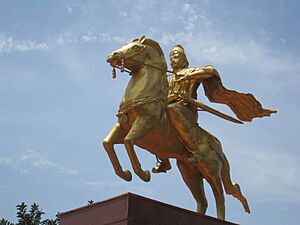
Schwartz Church is a historic building in the palace garden. Serfoji II built it in 1779 for Rev. C.V. Schwartz. There are five museums in the city. These include the Archeological Museum and the Saraswathi Mahal Library Museum. The Raja Rajan Manimandapam is another tourist spot. It was built for the Thanjavur Tamil Conference in 1991.
Thanjavur is a center for many arts and crafts in South India. Carnatic music was organized here and grew during the Nayak rule in the 16th century. Bharathanatyam, a classical South Indian dance, also developed its main styles in Thanjavur.
Sathaya Thiruvizha is the yearly birthday festival for Rajaraja Chola I. It happens every October. Thanjavur is also a base for the Tyagaraja Aradhana. This is a Carnatic music festival held every January or February in Thiruvaiyaru, about 13 km (8.1 mi) away.
Thanjavur painting is a major classical painting style from this area. It started around the 1600s, when the Nayakas of Thanjavur encouraged art, dance, and music. These paintings often combine raised and painted surfaces. The Hindu god Krishna is a very popular subject. Today, these paintings are popular souvenirs and art pieces.
Thanjavur's Economy: How People Make a Living

Most people in Thanjavur work in tourism and service jobs. But farming is also a very old and important job here. Thanjavur is known as the "Rice bowl of Tamil Nadu." Paddy (unmilled rice) is the main crop. Other crops grown include blackgram, banana, coconut, gingelly, ragi, red gram, green gram, sugarcane, and maize. About 58% of the land is good for farming.
There are three farming seasons in Thanjavur: Kuruvai (June to September), Samba (August to January), and Thaladi (September, October to February, March). The city is a central point for moving food grains from the nearby Cauvery Delta areas. Organic farming is also becoming more common among farmers in Thanjavur. Even though farming is key, only 7% of the people work directly in it. However, a lot of trade related to farming happens in the city.
Growing almonds has become popular in Thanjavur. The warm, dry weather and good soil are perfect for almonds. Thanjavur almonds are known for being high quality and tasty. Almond trees bloom in early spring, and the nuts are ready in the fall. Almond farming has become an important way for local farmers to earn money.
Thanjavur is also a big center for silk weaving in Tamil Nadu. In 1991, there were 200 silk weaving businesses, employing about 80,000 people. The city is also famous for 'Thalaiyatti bommai', or 'Dancing dolls'. These dolls are made from clay, wood, or plastic.
The city also makes bell metal crafts like Thanjavur metal plates, bronze statues, and bowls. They also make pith works, which are models of Hindu idols and other figures. Making musical instruments like the veena, tambura, violin, mrithamgam, thavil, and kanjira is another important activity.
Many big nationalized banks and private banks have branches in Thanjavur. These banks also have automated teller machines (ATMs) around the city.
People and Languages in Thanjavur
| Religious census | ||||
|---|---|---|---|---|
| Religion | Percent(%) | |||
| Hindu | 82.87% | |||
| Muslim | 8.34% | |||
| Christian | 8.58% | |||
| Sikh | 0.01% | |||
| Buddhist | 0.01% | |||
| Jain | 0.06% | |||
| Other | 0.11% | |||
| No religion | 0.01% | |||
| Historical population | ||
|---|---|---|
| Year | Pop. | ±% |
| 1871 | 52,171 | — |
| 1881 | 54,745 | +4.9% |
| 1891 | 54,390 | −0.6% |
| 1901 | 57,870 | +6.4% |
| 1911 | 60,341 | +4.3% |
| 1921 | 59,913 | −0.7% |
| 1931 | 66,889 | +11.6% |
| 1941 | 68,702 | +2.7% |
| 1951 | 100,680 | +46.5% |
| 1961 | 111,099 | +10.3% |
| 1971 | 140,547 | +26.5% |
| 1981 | 184,015 | +30.9% |
| 1991 | 202,013 | +9.8% |
| 2001 | 215,725 | +6.8% |
| 2021 | 492,943 | +128.5% |
| Sources:* 2011: | ||
In 2011, Thanjavur had about 250,000 people. There were 1,042 females for every 1,000 males, which is higher than the national average. About 19,860 children were under six years old. The city's average literacy rate was 83.14%, higher than the national average of 72.99%.
Most people in Thanjavur are Hindus (82.87%). There are also many Muslims (8.34%) and Christians (8.58%). A small number of people follow other religions.
Tamil is the most spoken language. Other languages spoken include Telugu, Thanjavur Marathi, and Saurashtra. Thanjavur is an important cultural and political center for the Thanjavur Marathi people. Most workers are in service industries like trade and business. As the city grows, there are fewer opportunities for farming.
Getting Around Thanjavur
National Highways NH 83 and NH 36 go through Thanjavur. NH 136 and NH 67 connect Thanjavur to Perambalur and Thiruvurur. The city has regular bus services to many other cities and towns.
Thanjavur used to have one bus station in the city center. A new, bigger bus station was built in 1997 to handle more passengers. Thanjavur also has a good local bus system. Government and private buses run often between the two bus stations and nearby towns and villages.
The railway line connecting Tiruchirappalli Junction railway station to Chennai Egmore through Thanjavur is very old. It was built in 1879. The Thanjavur railway junction has three railway lines going to Tiruchirapalli, Kumbakonam, and Thiruvarur. Thanjavur is connected by train to most major cities and towns in India. There are daily express trains to places like Chennai, Mysuru, and Madurai. There are also weekly trains to other cities across India.
In the early 1990s, Thanjavur had a flight service to Chennai, but it stopped. A full air force station is now open in Thanjavur. It became a major air base in 2013. The Thanjavur Air Force Station has a squadron of Sukhoi Su-30 Fighter aircraft. This makes it the first fighter squadron in Tamil Nadu. The closest airport for public travel is Tiruchirapalli International Airport. The nearest seaport is in Nagapattinam.
Learning and Education in Thanjavur
Thanjavur has four universities: Periyar Maniammai Institute of Science & Technology, PRIST University, SASTRA University, and Tamil University. The Tamil University is a state university started in 1981. It focuses on advanced research in the Tamil language and related subjects.
Thanjavur has 15 arts, science, and management colleges, and nine engineering colleges. The Thanjavur Medical College was started in 1961. It is one of the oldest medical colleges in Tamil Nadu. The Indian Institute of Food Processing Technology is a center for food processing research.
The Saraswati Mahal Library, from the late 16th century, and the Central Library are the two main libraries in the city. There are 20 registered schools in Thanjavur for primary, secondary, and higher secondary education. St. Peter's Higher Secondary School was founded in 1784 by Rev. C F Schwartz. It was the first school in South India to teach English to local people. St. Antony's Higher Secondary School, started in 1885, is another old school. Christian missionaries helped a lot in promoting English education in Thanjavur. Kalyanasundaram Higher Secondary School, established in 1891, is also one of the city's oldest schools.
City Services in Thanjavur
The Tamil Nadu Electricity Board (TNEB) provides electricity to Thanjavur. The Thanjavur Corporation supplies water from the Vadavar Canal. In 2000–01, about 31 million liters of water were supplied daily to homes.
About 110 metric tonnes of waste are collected from Thanjavur every day. The city's sanitation department collects and sorts the waste. The underground drainage system covers 70% of the city. The corporation maintains 155 km (96 mi) of storm water drains.
Thanjavur has 37 hospitals and seven clinical labs for healthcare. There are 9,745 street lamps in the city. The corporation runs three markets: Serfoji Market, Amarar Swaminathan Market, and Kamaraj Market. The Bharat Sanchar Nigam Limited (BSNL) provides phone and internet services. The Regional Passport office in Trichy also has a Passport Seva Kendra (PSK) in Thanjavur.
Nearby Villages
Some villages near Thanjavur city that are part of the Thanjavur metropolitan area include:
- Avusahibthottam
- Villar
- Nanjikottai
- Vallam
- Neelagiri
- Mariamman Kovil
- Velur, Thanjavur
See also
 In Spanish: Thanjavur para niños
In Spanish: Thanjavur para niños


